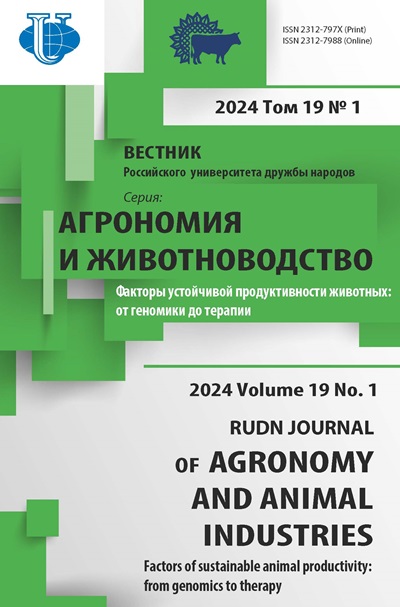ASSESSMENT OF NITRITE LEVEL - NITRIC OXIDE DERIVATIVE - IN HORSES WITH INTESTINAL COLIC BY ESR SPECTROSCOPY
- Authors: Artyushina Z.S1, Abramov P.N1, Polyansky N.B2, Tkachev N.A3, Serezhenkov V.A3
-
Affiliations:
- Moscow state academy of veterinary medicine and biotechnology named K.I. Skryabin
- Emanuel Institute of Biochemical Physics, Russian Academy of Sciences
- Semenov Institute of Chemical Physics, Russian Academy of Sciences
- Issue: Vol 14, No 1 (2019)
- Pages: 57-65
- Section: Veterinary science
- URL: https://agrojournal.rudn.ru/agronomy/article/view/19474
- DOI: https://doi.org/10.22363/2312-797X-2019-14-1-57-65
Cite item
Full Text
Abstract
The pathogenesis of diseases of the digestive tract of horses, accompanied by the development of inflammation and oxidative stress, can be associated with a lack of nitrogen monoxide, which controls a variety of signaling pathways in the body. Nitrogen monoxide (NO) takes part in the work of the immune and nervous systems, its level directly determines the tone of all blood vessels and the course of many pathological processes. NO should be considered as one of the most important factors in the protection of the gastric and intestinal mucosa. The article describes in detail the method for determining the level of nitrite-nitric oxide metabolite - in diseases of horses with the symptom complex of “true” colic, and also presents the results of measurements of nitrite in the serum of healthy animals of two age groups: 1-5 years and 6-25 years and animals with pathology. The concentration of nitrite in blood serum in horses of the age group of 6-25 years was 3.42 ± 4.22 μM, while in young animals (1-5 years) the level of this indicator was 8.24 ± 5.42 μM, which is 2,4 times higher. A sharp decrease of nitrite was noted in all horses with intestinal diseases of 2.07 ± 0.9 μM, especially with meteorism 0.6 ± 0.4 μM and spastic colic 1.78 ± 0.5 μM. These facts determine the diagnostic and prognostic value of nitric oxide as a biomarker for the regulation of intestinal motility in normal and pathological conditions.
About the authors
Zinaida S Artyushina
Moscow state academy of veterinary medicine and biotechnology named K.I. Skryabin
Author for correspondence.
Email: artyshina.zinaida@yandex.ru
-
Moscow, 109472, Russian FederationPavel N Abramov
Moscow state academy of veterinary medicine and biotechnology named K.I. Skryabin
Email: Abramov_P@inbox.ru
-
Moscow, 109472, Russian Federation
Nikolai B Polyansky
Emanuel Institute of Biochemical Physics, Russian Academy of Sciences
Email: npolinski@mail.ru
-
Moscow, 119334, Russian FederationNikolai A Tkachev
Semenov Institute of Chemical Physics, Russian Academy of Sciences
Email: nitkachev@yandex.ru
-
Moscow, 119991, Russian FederationVladimir A Serezhenkov
Semenov Institute of Chemical Physics, Russian Academy of Sciences
Email: serezhenkov@yandex.ru
-
Moscow, 119991, Russian FederationReferences
- Mokh VP, Poltorakov AP, Serezhenkov VA, Vanin AF. On the nature of a compound formed from dinitrosyl-iron complexes with cysteine and responsible for a long-lasting vasorelaxation. Nitric Oxide. 2010; 22(4):266—274. Available from: doi: 10.1016/j.niox.2010.01.002.
- Rocks SA, Davies CA, Hicks SL, Webb AJ, Klocke R, Timmins GS et al. Measurement of S-nitrosothiols in extracellular fluids from healthy human volunteers and rheumatoid arthritis patients, using electron paramagnetic resonance spectrometry. Free Radical Biology & Medicine. 2005; 39(7):937—948. Available from: doi: 10.1016/j.freeradbiomed.2005.05.007.
- Galvin N, Dillon H, McGovern F. Right dorsal colitis in the horse: minireview and reports on three cases in Ireland. Irish Veterinary Journal. 2004; 57(8):467—473. Available from: doi: 10.1186/2046-0481-57-8-467.
- Mirza MH, Seahorn TL, Oliver JL, Hosgood G, Moore RM. Detection and comparison of nitric oxide in clinically healthy horses and those with naturally acquired strangulating large colon volvulus. Can J Vet Res. 2005; 69:106—115.
- Kleinbongard P, Dejam A, Lauer T, Rassaf T, Schindler A, Picker O et al. Plasma nitrite reflects constitutive nitric oxide synthase activity in mammals. Free Radic Biol Med. 2003; 35(7): 790—796. Available from: doi: 10.1016/S0891-5849(03)00406-4.
- Tsikas D. A critical review and discussion of analytical methods in the L-arginine/nitric oxide area of basic and clinical research. Anal Biochem 2008; 379(2):139—216. Available from: doi: 10.1016/j.ab.2008.04.018.
- Jackson SK, Thomas MP, Smith S, Madhani M, Rogers SC James PE. In vivo EPR spectroscopy: biomedical and potential diagnostic applications. Faraday Discuss. 2004; 126: 103—117. Available from: doi: 10.1039/B307162F.
- Drozdov VN. NSAIDs with their own mechanism of protection of the stomach — is it real? Russian Medical Journal. 2013; 21(30):1596—1599. (In Russ)
- Dijkstra G, van Goor H, Jansen PL, Moshage H. Targeting nitric oxide in the gastrointestinal tract. Cur Opin Invest Drugs. 2004; 5(5):529—36.
- Kovach M. Colic in horses. Causes. Diagnosis. Treatment. Moscow: Korolevskii Izdatel'skii Dom Publ.; 2010. (In Russ).
- White NA, Edwards B. Handbook of Equine Colic. Oxford: Butterworth-Heinemann; 2001.
- Robinson NE. Current Therapy in Equine Medicine. 5th Edition. Saunders; 2003.
















